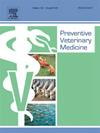Human-animal interactions, occupational health and well-being in pig slaughterhouses of Colombia: Exploring worker perceptions and practices
IF 2.2
2区 农林科学
Q1 VETERINARY SCIENCES
引用次数: 0
Abstract
Public concern about global health has forced the meat industry to make technological, operational and logistical improvements, but human-animal interactions are rarely considered from an animal welfare perspective. A total of 171 workers from 12 pig slaughterhouses were interviewed about their occupational perceptions and practices affecting their health and well-being, and human-pig interactions. Ninety percent of the workers interviewed were male, between 18 and 30 years old, with high school education, < 7 years of experience, and learned their work in the slaughterhouse. In terms of human-animal interactions, we found that the nature of the tasks performed by each worker had an impact on their perceptions of pigs, particularly those involving work with live animals (outdoors) and stunning and bleeding (indoors). In addition, respondents show disapproval of cruel practices and a high level of awareness of pig pain and concern to alleviate it. However, there are neutral responses to statements that show some weakness in their feelings towards pigs. Forty per cent of respondents reported having at least one of the health problems and had suffered occupational accidents. The most common types of accidents were falls, cuts and animal aggression. These accidents were related to incorrect movements, especially in the morning, by personnel > 40 years of age, with > 7 years of experience, and the upper and/or lower extremities were most affected. Our results indicate that fatigue caused by factors such as line speed, uncoordinated operations, and risky behavior by workers, is the main cause of workplace accidents in slaughterhouses. Based on this evidence, we conclude that adjustments of work break/rest intervals and improvements of working conditions are necessary to reduce fatigue, improve safety, and enhance work efficiency.
人与动物的相互作用,职业健康和福祉在哥伦比亚的猪屠宰场:探索工人的看法和做法
公众对全球健康的关注迫使肉类行业在技术、运营和后勤方面进行改进,但很少从动物福利的角度考虑人与动物的互动。对来自12个生猪屠宰场的171名工人进行了访谈,内容涉及影响其健康和福祉的职业观念和做法,以及人与猪的互动。90%的受访工人是男性,年龄在18岁到30岁之间,受过高中教育,<; 有7年的工作经验,他们是在屠宰场学习工作的。在人与动物的互动方面,我们发现每个工人所执行的任务的性质会影响他们对猪的看法,特别是那些涉及活的动物(户外)和眩晕和出血(室内)的工作。此外,受访者表示不赞成残忍的做法,对猪的痛苦有很高的认识,并关注减轻这种痛苦。然而,对于那些表现出对猪感情软弱的言论,他们的反应是中立的。40%的答复者报告至少有一种健康问题,并遭受过职业事故。最常见的事故类型是跌倒、割伤和动物攻击。这些事故都与不正确的动作有关,特别是在早上,人员>; 40岁,>; 7年的经验,上肢和/或下肢受影响最大。研究结果表明,流水线速度、作业不协调、工人的危险行为等因素导致的疲劳是屠宰场工作事故的主要原因。基于这些证据,我们得出结论,调整工作休息间隔和改善工作条件对于减少疲劳、提高安全性和提高工作效率是必要的。
本文章由计算机程序翻译,如有差异,请以英文原文为准。
求助全文
约1分钟内获得全文
求助全文
来源期刊

Preventive veterinary medicine
农林科学-兽医学
CiteScore
5.60
自引率
7.70%
发文量
184
审稿时长
3 months
期刊介绍:
Preventive Veterinary Medicine is one of the leading international resources for scientific reports on animal health programs and preventive veterinary medicine. The journal follows the guidelines for standardizing and strengthening the reporting of biomedical research which are available from the CONSORT, MOOSE, PRISMA, REFLECT, STARD, and STROBE statements. The journal focuses on:
Epidemiology of health events relevant to domestic and wild animals;
Economic impacts of epidemic and endemic animal and zoonotic diseases;
Latest methods and approaches in veterinary epidemiology;
Disease and infection control or eradication measures;
The "One Health" concept and the relationships between veterinary medicine, human health, animal-production systems, and the environment;
Development of new techniques in surveillance systems and diagnosis;
Evaluation and control of diseases in animal populations.
 求助内容:
求助内容: 应助结果提醒方式:
应助结果提醒方式:


